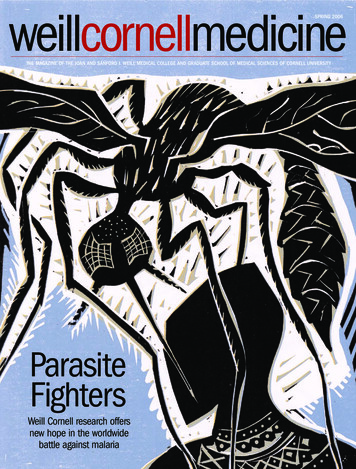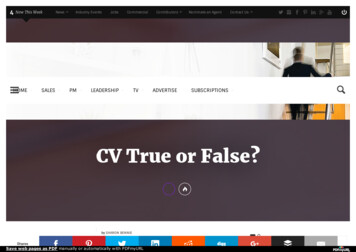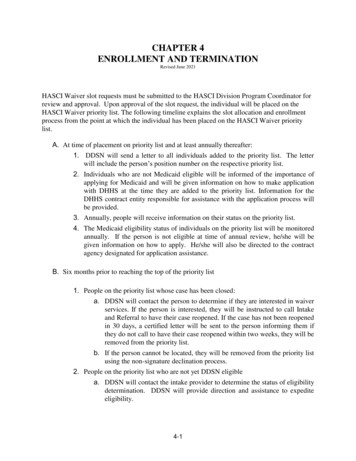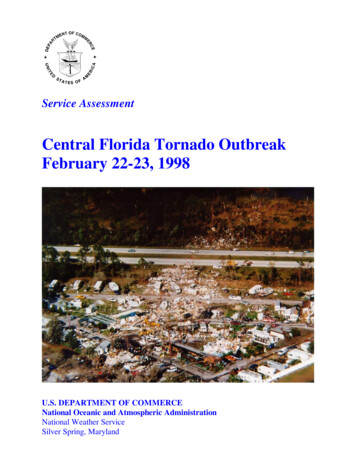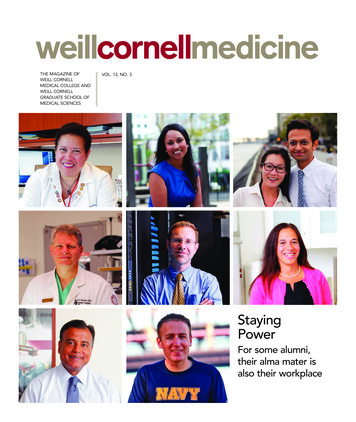
Transcription
c1-c1WCMvol13no3 WCM redesign 11 08 11/12/14 2:15 PM Page 1weillcornellmedicineTHE MAGAZINE OFWEILL CORNELLMEDICAL COLLEGE ANDWEILL CORNELLGRADUATE SCHOOL OFMEDICAL SCIENCESVOL. 13, NO. 3StayingPowerFor some alumni,their alma mater isalso their workplace
c2-c4WCMvol13no3 WCM redesign 11 08 11/7/14 9:57 AM Page c2
01-02WMCvol13no3toc WCM redesign 11 08 11/7/14 10:00 AM Page 1weillcornellmedicineTHE MAGAZINE OFWEILL CORNELL MEDICALCOLLEGE AND WEILL CORNELLGRADUATE SCHOOL OFMEDICAL SCIENCESVOL. 13, NO. 334FEATURES22 THE HOME TEAMPHOTOGRAPHS BY JOHN ABBOTTThe Medical College faculty boasts dozens of men and women who not only have“MD” and/or “PhD” after their names, but a Weill Cornell class year as well. A significant number of alumni return to campus after completing their training—while somenever leave, doing their residencies at NYP/Weill Cornell and staying on to becomeprofessors. Many have gone on to spend their careers here, forging decades-long relationships with the institution and with each other. Weill Cornell Medicine offers portraits of some of them—from venerable veterans to young residents at the beginning oftheir careers.34 CLOSING THE GAPHEATHER SALERNOFor address changes andother subscription inquiries,please e-mail us atwcm@med.cornell.eduTwitter: geYouTube.com/WCMCnewsFrom the Heart-to-Heart program to the student-run Community Clinic, Weill Cornellworks on numerous fronts to provide care to underserved New Yorkers. Faculty and students have partnered with groups and agencies around the city in an effort to addressthe health inequities that plague socioeconomically disadvantaged residents. “Whensomeone has to take care of a family and worry about paying the bills, health may notbe a priority,” notes Carla Boutin-Foster, MD, MS ’99, director of the ComprehensiveCenter of Excellence in Disparities Research and Community Engagement. “It’s not adeficiency that they have; it’s just reality. People are constantly making tradeoffs when itcomes to their own health, especially when they don’t feel ill.”Cover photos by John AbbottVOL. 13, NO. 31
01-02WMCvol13no3toc WCM redesign 11 08 11/7/14 10:00 AM Page 2weillcornellmedicineTHE MAGAZINE OF WEILL CORNELL MEDICALCOLLEGE AND WEILL CORNELL GRADUATESCHOOL OF MEDICAL SCIENCESPublished by the Office of External AffairsWeill Cornell Medical College andWeill Cornell Graduate School ofMedical SciencesWEILL CORNELL SENIOR ADMINISTRATORSLaurie H. Glimcher, MDThe Stephen and SuzanneWeiss Dean, Weill Cornell MedicalCollege; Provost for Medical Affairs,Cornell UniversityLarry SchaferVice Provost for External AffairsWEILL CORNELL EXECUTIVE DIRECTOROF COMMUNICATIONS AND PUBLIC AFFAIRSMason EssifWEILL CORNELL DIRECTOR OFCREATIVE AND EDITORIAL SERVICES12John RodgersWEILL CORNELL SENIOR EDITORJordan LiteWeill Cornell Medicine is produced bythe staff of Cornell Alumni Magazine.EDITORBeth SaulnierCONTRIBUTING EDITORSChris FurstAdele RobinetteSharon TregaskisEDITORIAL ASSISTANTTanis FurstART DIRECTORStefanie GreenASSISTANT ART DIRECTORDEPARTMENTS3 DEAN’S MESSAGEComments from Dean Glimcher4 THE CAMPAIGNFOR EDUCATION6 LIGHT BOXA model mind88 SCOPEFunding medical education. Plus: Cornell’s new president, Reunion 2014, Cantley andLord elected to IOM, early OR experience, new roles for two faculty leaders, the WhiteCoat Ceremony, and celebrating the Sesquicentennial.Lisa Banlaki FrankACCOUNTING MANAGERBarbara BennettEDITORIAL AND BUSINESS OFFICES401 E. State St., Suite 301Ithaca, NY 14850(607) 272-8530; FAX (607) 272-853212 TALK OF THE GOWNNew curriculum debuts. Plus: Maternal clot risk, a medical thriller, pioneer in palliativecare, solar-powered cancer test, dermatological mysteries, hair-sparing “cold caps,” andDr. Heimlich publishes a memoir.40 NOTEBOOKNews of Medical College and Graduate School alumni47 IN MEMORIAMAlumni remembered48 POST DOCLights, camera, Code BlackPrinted by The Lane Press, South Burlington, VT.Copyright 2014. Rights for republication ofall matter are reserved. Printed in U.S.A.2WEILL CORNELL MEDICINEWeill Cornell Medicine (ISSN 1551-4455) is produced four times a year by Cornell Alumni Magazine, 401 E. State St., Suite 301,Ithaca, NY 14850-4400 for Weill Cornell Medical College and Weill Cornell Graduate School of Medical Sciences. Third-classpostage paid at New York, NY, and additional mailing offices. POSTMASTER: Send address changes to Office of External Affairs,1300 York Ave., Box 123, New York, NY 10065.
03-03WCMvol13no3dean WCM redesign 11 08 11/7/14 10:01 AM Page 3Dean’s Message150 Reasons—and Many More—to Celebrate WCMCand CornellIn September, with the Empire State Buildingshining red and white for the occasion,Cornell University kicked off a series ofevents it is hosting around the world to markthe University’s Sesquicentennial. With an afternoon and evening of performances at Jazz atLincoln Center entitled “The Big Idea!,” alumni,friends, faculty, and staff from Ithaca andNew York City celebrated with a programhighlighting Cornell’s founding ideas:blending sciences and humanities, making education accessible to a diversegroup of students, and using knowledgeand discoveries to improve the world.At Weill Cornell, we have been educating physicians and scientists withthose goals in mind since we opened ourdoors in 1898 as one of only a few medical schools that admitted women. Today,our students come from around the country and the world already in possession ofan astonishingly diverse range of interestsand personal accomplishments. Now,they undertake a new curriculum thathonors science as the foundation of modern medicine, instills critical thinking andindependent habits of inquiry, and putsthe patient at the center of everythingLISA BERGthey do. Through our new Campaign forEducation, we hope they will leave us preparedto become global leaders in medicine and biomedical research, working to improve healthcare systems around the world.For more than a century, our alumni—over350 of whom gathered in October for an evolution of medical education-themed reunion—have done just that. The Weill Cornell graduatesin our photo feature have taken Weill Cornell’spatient-centered approach to heart, long beforethat term gained widespread currency, and areLaurie H. Glimcher, MD,Dean of the Medical Collegefully aware of the tremendous responsibilitythat we in the medical profession bear. Theirpower is most obviously on display in the discoveries and therapeutic breakthroughs theyhave made. And they’ve been widely recognizedand honored for their work saving lives andadvancing the world’s knowledge and understanding of medicine, while never losing theindividual power to heal.Our graduates and our current students alsowield their power in ways that are less obviousbut no less profound. Whether as advocates fortheir patients or as learners tackling WeillCornell’s new curriculum, which blends clinicaland scientific education during all four years ofmedical school, they demonstrate their greatnessin countless private moments of caring. Theseinteractions between patients and their physicians, whether rich in experience or still intraining, demand empathy, compassion, andhumility. Often, these moments remain unknown, unheralded, and unseen except by thosefor whom the quality of care matters most.The power of patient-centered practice is thepower of observation and creativity. Throughouttheir careers, day in and day out—in the labwith colleagues or at the bedside with patientsand their families—our alumni show curiosity,courage, and imagination. They ask questions,seek answers, share ideas, and pursue excellence.Sometimes they fail—and, learning from thosereversals, they have the fortitude, commitment,and resilience to try again.In these and many other ways, Weill Cornellalumni continue to drive medicine and the biomedical sciences forward—improving our college, our university, our profession, and ourworld. It’s my hope and my belief that they willcontinue to sustain and strengthen Weill Cornelland Cornell University for the next 150 years.VOL. 13, NO. 33
04-05WCMvol13no3dev WCM redesign 11 08 11/7/14 10:01 AM Page 4
04-05WCMvol13no3dev WCM redesign 11 08 11/7/14 10:02 AM Page 5VOL. 13, NO.35
06-07WCMvol13no3lightbox WCM redesign 11 08 11/7/14 10:02 AM Page 6Light BoxMind Over MatterA model of the brain’s white matterbecame a work of art when it went ondisplay at Philadelphia's FranklinInstitute this summer. The piece, measuring two-and-a-half feet wide, was thecenterpiece of an exhibit entitled “YourBrain.” It was created through 3-D printing from an MRI image by physicistHenning Voss, PhD, the Nancy M. andSamuel C. Fleming Research Scholar inIntercampus Collaborations.AMERICAN PRECISION PROTOTYPING6WEILL CORNELL MEDICINE
06-07WCMvol13no3lightbox WCM redesign 11 08 11/7/14 10:03 AM Page 7VOL. 13, NO. 27
08-11WCMvol13no3scope WCM redesign 11 08 11/7/14 10:03 AM Page 8ScopeNews BriefsPETER HUNGClass consciousness: The Medical College’s new fundraising effort focuses on enriching the student experience.New Campaign Supports Medical EducationA 50 million fundraising campaign aims tosupport and enhance medical education atWeill Cornell. Launched in October, the effortis part of the current Driving Discoveries,Changing Lives campaign. “We at WeillCornell pride ourselves on providing exceptional medical education and training to our aspiring physiciansand scientists, and the Campaign for Education will take WeillCornell to the next level of excellence,” says Dean LaurieGlimcher, MD. “The campaign will support our extraordinaryefforts to transform our curriculum and ensure that we shape thebest doctors who are dedicated to improving the lives of patients.”The campaign will help support Weill Cornell’s new curriculum,which integrates basic science with clinical care and focuses on across-disciplinary, thematic view of medicine. (For an in-depth lookat the curriculum, see page 12.) It will raise money to fund facultyendowments and student scholarships, as well as to supportimprovements to the Weill Education Center, including its mainauditorium, teaching labs, and classrooms. “Weill Cornell has longbeen a driver of excellence in medical education, and the Campaignfor Education will ensure that we remain at the vanguard,” saysSanford Ehrenkranz, a member of the Board of Overseers and campaign co-chair. “I can think of no better investment than supporting our faculty and students.”8WEILL CORNELL MEDICINECornell Names Thirteenth PresidentIn late September, the Board of Trustees approved the appointmentof Elizabeth Garrett, provost and senior vice president for academicaffairs at the University of Southern California (USC), as Cornell’snext president. She will assume the presidency on July 1, 2015,when David Skorton, MD, steps down to become secretary of theSmithsonian Institution in Washington, D.C. Garrett is the firstwoman to lead the University; her hiring means that half of theschools in the Ivy League will have female presidents. “I am honored to have been selected as the next leader of this remarkableinstitution,” Garrett says. “Cornell is one of the world’s truly greatuniversities, with a stellar commitment to excellence in teaching,research, scholarship, and creative activity, linked with a deep commitment to public engagement. I am excited to join the Cornellcommunity and to work with the faculty, staff, students, and alumni to chart the next chapter in its illustrious history.”Garrett’s résumé includes clerking for Supreme Court JusticeThurgood Marshall and serving as legislative director for OklahomaSenator David Boren. In 2005, President George W. Bush appointedher to the bipartisan Advisory Panel on Federal Tax Reform. From2009 to 2013, she served on the California Fair Political PracticesCommission, the state’s independent political oversight agency.Garrett was appointed to her current position in 2010. As USC’s sec-
08-11WCMvol13no3scope WCM redesign 11 08 11/7/14 10:03 AM Page 9ROBERT BARKER / CORNELL UNIVERSITY PHOTOGRAPHYour history. As a great research university, Cornell has the power tomake a difference in the world, and I am thrilled to see what wecan accomplish.”Before joining USC, Garrett was a law professor at theUniversity of Chicago, where she also served as deputy dean foracademic affairs. She earned a BA in history with special distinctionfrom the University of Oklahoma and a JD from the University ofVirginia School of Law. Her scholarly interests include the legislative process, the design of democratic institutions, the federal budget process, and tax policy. At Cornell, she will be a tenured facultymember in the Law School with a joint appointment in government. Her husband, Andrei Marmor, DPhil, is a professor of philosophy and the Maurice Jones Jr. Professor of Law at USC. He willjoin the Cornell faculty as a full professor with joint appointmentsin the College of Arts and Sciences and the Law School.Current and future: Cornell president-elect Elizabeth Garrett (left)with outgoing president David Skorton, MDReunion Weekend Draws a Crowdond-ranking officer, she oversees its college of arts and sciences, theKeck School of Medicine, and sixteen other professional schools, inaddition to the divisions of student affairs, research, libraries, andmore. She sits on the USC Health Systems Board that oversees threehospitals and eighteen clinical practices and chairs the KeckMedical Center Oversight Committee. “It’s an exciting time atCornell University as we celebrate our 150th anniversary andreflect on our reputation of championing excellence in education,”says Dean Glimcher. “With Beth joining the Cornell family as itsfirst female president, we have forged a pioneering new chapter inReunion 2014 drew more than 350 alumni back to campus for a festive weekend that included campus tours, a gala dinner dance,remarks from Dean Glimcher, and more. Held in mid-October, theevent was built around the theme of the evolution of medical education. Alumni had the chance to chat with current students, visitnew facilities like the Belfer Research Building and the Margaret andIan Smith Clinical Skills Center, and get a first-hand look at howmed school has changed since they graduated. The weekend set arecord for overall attendance, with top honors going to the Class of1983, followed by 1964 and 1984. Special achievement awards werepresented to Bruce Gellin, MD ’83, and Rev. Peter Le Jacq, MD ’81.TIP OF THE CAP TO. . .Francis Barany, PhD, professor of microbiology and immunology, winner of the IFCC Award for Significant Contributions toMolecular Diagnostics from the International Federation ofClinical Chemistry and Laboratory Medicine.Tara Bishop, MD ’02, the Nanette Laitman Clinical Scholar inPublic Health–Clinical Evaluation, winner of the Mid-AtlanticSociety of General Internal Medicine Clinician-Investigator Award.Brian Bosworth, MD, the Anne and Ken Estabrook ClinicalScholar in Gastroenterology, named president of the New YorkSociety for Gastrointestinal Endoscopy.Pharmacology postdoc Dilek Colak, PhD, named a finalist inlife sciences for the Blavatnik Regional Awards for YoungScientists from the New York Academy of Sciences.Donald D’Amico, MD, chairman of ophthalmology and theJohn Milton McLean Professor of Ophthalmology, winner of aLifetime Achievement Honor Award from the AmericanAcademy of Ophthalmology.Joseph Fins, MD ’86, the E. William Davis Jr., MD, Professor ofMedical Ethics, elected to the International NeuroethicsSociety’s board of directors.Timothy Hla, PhD, professor of pathology and laboratory medicine and professor of neuroscience in the Feil Family Brain andMind Research Institute, winner of an Outstanding Achievement Award from the Eicosanoid Research Foundation.Ravinder Mamtani, MD, professor of healthcare policy andresearch (education), reappointed to the State Board forProfessional Medical Conduct.Christopher Mason, PhD, assistant professor of computationalgenomics in the HRH Prince Alwaleed Bin Talal Bin AbdulazizAlsaud Institute for Computational Biomedicine, named one ofPopular Science magazine’s “Brilliant Ten.”Fabrizio Michelassi, MD, chairman of surgery and the LewisAtterbury Stimson Professor of Surgery, elected president of theSociety for Surgery of the Alimentary Tract.Michael Pesko, PhD, the Walsh McDermott Scholar in PublicHealth, named to Forbes’s “30 Under 30 Who Are Changing TheWorld 2014 in Science & Healthcare.”Gregory Petsko, DPhil, the Arthur J. Mahon Professor ofNeurology and Neuroscience in the Feil Family Brain and MindResearch Institute and director of the Helen and Robert AppelAlzheimer’s Disease Research Institute, winner of the M. J.Buerger Award from the American Crystallographic Association.Robbyn Sockolow, MD, associate professor of pediatrics,named a Woman of Distinction in Medicine by the Crohn’s andColitis Foundation of America.VOL. 13, NO. 39
08-11WCMvol13no3scope WCM redesign 11 08 11/7/14 10:03 AM Page 10WCMCWEST VIRGINIA WESLEYAN COLLEGECantley, Lord Elected to IOMJOHN ABBOTTLewis Cantley,PhD ’75Catherine Lord,PhDTwo prominent faculty members have beenelected to the Institute of Medicine of theNational Academies, one of the field’s highesthonors. Lewis Cantley, PhD ’75, is theMargaret and Herman Sokol Professor inOncology Research, the Meyer Director of theSandra and Edward Meyer Cancer Center, anda professor of cancer biology in medicine.Catherine Lord, PhD, is the DeWitt SeniorScholar, director of the Center for Autism andthe Developing Brain at NewYork-Presbyterian,and a professor of psychology in psychiatryand of psychology in pediatrics. The two areamong seventy new members and ten foreignassociates elected to the IOM this year. Theannouncement was made at the group’s annual meeting in October.‘PreOp’ Gives Students EarlyExperience in SurgeryPerfect fit: Faculty help students into their new uniforms.A new program is giving first-year students anup-close look at surgery. Through a preclinical surgical programknown as PreOp, students can participate in procedures in the operating room, helping inspire them to careers in the field. Whileother schools have surgical-exposure programs, PreOp’s structureand extensive skills component make it unique, says co-creatorStefanie Lazow ’16, who founded it with classmate Rachael Venn’16. Ten participants work with ten attendings, rotating to a newmentor each month to experience a variety of subfields throughoutthe year. Students observe surgeries, attend lectures, participate inskills sessions, and often scrub in. “It can be difficult for medicalstudents to figure out what they’re interested in doing,” observesGregory Dakin, MD, associate professor of surgery and PreOp’s faculty adviser. “In addition, surgery has the added complexity ofmanual dexterity that first- and second-year students don’t necessarily know they have.”The program has already influenced students’ career plans.While 44 percent of participants reported being very likely to applyfor a surgical residency at the beginning of PreOp, by the end of theyear that had risen to 78 percent.First-Years Don Their White CoatsNew Roles for Hempstead, Storey-JohnsonSesquicentennial Kicks Off in NYCBarbara Hempstead, MD, PhD, associate dean for faculty development and diversity and the O. Wayne Isom Professor of Medicine,has been appointed senior associate dean for education, effectiveJanuary 1. She succeeds Carol Storey-Johnson, MD ’77, who hasheld the position since 2001 and has been appointed senior adviser for medical education. In her new role, Hempstead will manageWeill Cornell’s medical education pedagogy; Storey-Johnson will,among other goals, help develop an infrastructure for evaluatingthe efficacy of the new curriculum and other programs. “We aretrying to propel Weill Cornell to the next level of excellence andcredibility in the world of medical education research,” StoreyJohnson says, “so that, in addition to our recognition for creating anew and novel curriculum, we can also develop the ability to determine and explain why it’s outstanding.”The University kicked off its Sesquicentennial celebrations—marking the 150th anniversary of the University’s founding—with aweekend of events in New York City in September. The festivitiesincluded a ceremonial lighting of the Empire State Building andcongratulations from the NASDAQ, which offered kudos on its massive sign in Times Square. The University’s marching band, gleeclub, and mascot (the Big Red Bear) appeared on Rockefeller Plazaoutside the “Today” show studios on a Saturday, the same day thatCornell launched its touring Sesquicentennial show with two performances at Jazz at Lincoln Center. Greg Petsko, DPhil, director ofthe Helen and Robert Appel Alzheimer’s Disease Research Instituteand the Arthur J. Mahon Professor of Neuroscience, made anappearance, speaking about his field and commenting on the phenomenon of the “Cornell brain.”10WEILL CORNELL MEDICINEThe 101 members of the Class of 2018 launched their medicalcareers in August with the traditional donning of white coats inUris Auditorium before a crowd of family and friends. “You are herefor a reason,” Dean Glimcher told them. “We chose you to join theClass of 2018 from more than 6,000 applicants because we believethat you can handle the immense responsibilities of learning howto take care of patients. Always put the patient at the center ofeverything you do.” The newly minted first-years also receivedstethoscopes, provided by the Buster Foundation’s Paul F. Miskovitz,MD ’75, Stethoscope Fund for Medical Students.The class’s fifty men and fifty-one women hail from twentystates and Canada; 18 percent of them are from demographicgroups underrepresented in medicine. Said Charles Bardes, MD,associate dean of admissions and professor of clinical medicine:“Your white coat indicates your joyful and solemn entrance into anoble, learned, and ancient profession whose purposes, above all,are to relieve suffering and to promote health.” In September, theQatar branch held its own White Coat Ceremony, welcoming theforty-one members of the incoming class.
08-11WCMvol13no3scope WCM redesign 11 08 11/7/14 10:03 AM Page 11Prostate Tumors, in VitroResearch at Weill Cornell and Sloan Kettering, published in Cell, has shown for the first time that tissue from prostate tumors can be grown in the lab,offering new avenues for testing drugs and personalizing treatment. “This represents a new tool tomove the results of cancer research closer to theeffective treatment of patients,” says co-firstauthor Andrea Sboner, PhD, assistant professor ofpathology and laboratory medicine and of computational genomics in computational biomedicineand a member of Weill Cornell’s Institute forPrecision Medicine. “We can now build biologicalmodels that closely resemble a patient’s tumor andbetter understand the mechanism of cancer progression and resistance in the context of new therapeutic agents that are being developed.”WCMC-Q Finds CalciumSignaling PathwayResearchers at the Qatar branch are exploring therole of calcium in biological processes. Work byRaphael Courjaret, PhD, research associate in physiology and biophysics, and Khaled Machaca, PhD,associate dean for research, has shed new light onthe complex role played by calcium ions, whichtransport information to various parts of the cell tofacilitate biochemical processes such as fertilization, muscle contraction, transmission of nervoussignals, and blood clotting. The research, publishedin Nature Communications, defined a novel pathway, dubbed “mid-range calcium signaling.”Pua Heads Lung CancerScreening EffortNYP/Weill Cornell has launched a screening program for those at risk for developing lung cancer.It uses low-dose CT scans to detect cancer in itsearliest stages, significantly increasing the odds ofsurvival. The program, which includes current andformer smokers and those with a close relativediagnosed with the disease, is led by Bradley Pua,MD, assistant professor of radiology. “As these CTscans will show things that do not necessarily represent cancer, joining a comprehensive center forscreening where multidisciplinary teams of physicians can meet on a routine basis to discuss andcontinue to refine screening guidelines is imperative,” Pua explains. “Accessibility to this team ofphysicians with expertise in every aspect of diagnosis to treatment will allow for more coordinatedcare, minimizing any screening harms.”Registries Key to SafetyA report by three health organizations—includingthe Medical Device Epidemiological NetworkScience Infrastructure Center at Weill Cornell—strongly endorses registries to address America’slack of a robust system for assessing the safetyand efficacy of medical devices. The report, alsoauthored by the Pew Charitable Trusts and theBlue Cross Blue Shield Association, ponders thepotential of registries to track such devices asimplantable defibrillators, cardiac valves, andjoint replacements. The registries would monitordevices as they move from clinical trials to themarketplace. “We currently have very limitedtools and means to understand how most devicesperform after they enter the healthcare market,”says Art Sedrakyan, PhD, director of the Centerand an associate professor of healthcare policyand research. “We rely on pre-market clinicalstudies or testing and assume that these devicesare good, but past experience proves that’s notthe case since a number of commonly useddevices ultimately fail or do not perform well.”In Practices, BiggerMay Not Be BetterSmaller physician practices may have betterpatient outcomes, reportsa paper in Health Affairs.Principal investigatorLawrence Casalino, MD,PhD, and colleaguesfound that practices thatare smaller or physicianowned—as opposed toLawrencelarger or hospitalCasalino,owned—had lower ratesMD, PhDof hospital admissionsthat could have been avoided with good primarycare. “That’s important, because right now hospitals are rapidly employing more and more physicians,” says Casalino, the Livingston FarrandProfessor of Public Health. “It’s happening veryfast and changing the landscape of practice, sofinding that hospital-owned physician practicesdid not perform as well should be interesting tophysicians, patients, hospital executives, andpolicymakers.” The findings are surprising, theresearchers say, because large and hospitalowned practices have more resources to hirestaff and create processes to improve care.ABBOTTFROM THE BENCHA Post-Surgical WarningAn irregular heartbeat that patients developafter surgery appears to predict future strokes,according to a study by Hooman Kamel, MD,assistant professor of neurology and neuroscience in the Feil Family Brain and MindResearch Institute, and postdoc Gino Gialdini,MD. The work, published in JAMA, found thatpatients who received a new diagnosis of atrialfibrillation (AF) while hospitalized for surgerywere more likely to suffer a stroke during thenext several years. The risk was greatest inpatients whose surgery did not involve theirheart—suggesting that AF triggered by thebody’s reaction to the physical and emotionalstress of surgery is a sign of higher stroke risk.In that group, 1.5 percent of patients with AFhad a stroke at one year, compared with 0.4percent without AF. “Many physicians view AFresulting from surgery as a temporary condition,and current guidelines don’t make specific recommendations for carefully monitoring thesepatients over time,” says Gialdini. “Our studysuggests that AF after surgery requires carefullong-term follow-up.” The researchers analyzeddata from some 1.7 million patients who werehospitalized for surgery throughout Californiaand found that 1.4 percent were newly diagnosed with AF afterward. Patients with previousAF or stroke were excluded.Autism Recovery Possible,Major Study FindsIt’s possible to recover from autism, sayresearchers from Weill Cornell and the Universityof Denver, who followed eighty-five childrenfrom their diagnosis as toddlers until their lateteens. Their study, in the Journal of ChildPsychology and Psychiatry, finds that 9 percentimproved to the point that they no longer metthe diagnostic criteria for autism. Another 28percent retained features of autism spectrumdisorder, such as impaired social functioning,but were doing well in several areas, particularlycognitive and academic functioning. Many inboth groups were enrolled in college. “This rateof improvement is much higher than has beenreported before, and that fact offers some verygood news,” says senior investigator CatherineLord, PhD, the DeWitt Wallace Senior Scholarand founding director of the Center for Autismand the Developing Brain, located on the WhitePlains psychiatric campus.Anesthesia Side EffectsAre Short-TermThe effects of a commonly used anesthetic onmemory and cognition appear to be temporary.The research, done in vitro using a rodentmodel, was conducted in response to concernsthat exposing children and elderly adults to general anesthesia may increase susceptibility tolong-term cognitive and behavioral deficits suchas learning disabilities. Says Hugh Hemmings Jr.,MD, PhD, chair of anesthesiology and the JosephF. Artusio Jr. Professor of Anesthesiology, one oftwo senior authors on the paper: “It is not clearwhether the residual effects after an operationare due to the surgery itself, or the hospitalization and attendant trauma, medications, andstress—or a combination of these issues.”Results were published in PLOS ONE.VOL. 13, NO. 311
12-21WCMvol13no3totg WCM redesign 11 08 11/7/14 10:04 AM Page 12Talk ofthe GownInsights & ViewpointsProgram of StudyFour years in the making,the new curriculum debutsThis August, on their very first day ofschool, the Class of 2018 encounteredsomeone whom medical students ofyears past couldn’t have imaginedmeeting so soon: a patient. A real, live patient.It was a first for the class and for Weill Cornell,marking the introduction of a new cu
Weill Cornell Medicine (ISSN 1551-4455) is produced four times a year by Cornell Alumni Magazine, 401 E. State St., Suite 301, Ithaca, NY 14850-4400 for Weill Cornell Medical College and Weill Cornell Graduate School of Medical Sciences.


